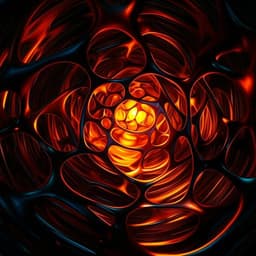
Engineering and Technology
High-entropy superparaelectrics with locally diverse ferroic distortion for high-capacitive energy storage
J. Duan, K. Wei, et al.
This groundbreaking research by Jianhong Duan, Kun Wei, Qianbiao Du, Linzhao Ma, Huifen Yu, He Qi, Yangchun Tan, Gaokuo Zhong, and Hao Li presents a novel approach to energy storage through entropy engineering. The creation of high-entropy superparaelectrics (SPEs) has resulted in exceptional energy density and storage efficiency, setting new benchmarks in the field.
~3 min • Beginner • English
Introduction
The study addresses the critical need for lead-free bulk dielectric ceramics that simultaneously deliver ultrahigh recoverable energy density (Wrec) and high energy storage efficiency (η) for capacitive energy storage. Conventional dielectric ceramic capacitors offer ultrafast charge/discharge and high power density but suffer from a trade-off between Wrec and η, especially under high electric fields where remnant polarization, hysteresis losses, and leakage currents increase. While antiferroelectric, ferroelectric, relaxor ferroelectric, and linear dielectric systems have shown partial progress, achieving both Wrec ≥ 15 J cm⁻³ and η ≥ 90% in bulk superparaelectrics under high fields remains challenging due to limitations in local structural design. The research proposes entropy engineering to disrupt long-range ferroelectric order, lower switching energy barriers, and construct flexible, locally heterogeneous polarization configurations, thereby inducing an ideal superparaelectric state with high polarization response, low Pr, delayed saturation, and high Eb.
Literature Review
Recent advances in lead-free bulk ceramics for energy storage include AgNbO3- and NaNbO3-based antiferroelectrics achieving Wrec of 11.4 and 18.5 J cm⁻³, respectively, but with η ≤ 80% due to AFE–FE transitions. Ferroelectric and relaxor ferroelectric systems such as KNN-, BKT-, and BF-based ceramics also often show limited η. Linear dielectrics (CaTiO3-, SrTiO3-based) can reach η > 90% but typically have Wrec < 7 J cm⁻³ due to low intrinsic polarization. Superparaelectrics (SPEs), a state in relaxors between Tm and TB characterized by weakly coupled polar nanoregions (PNRs), have emerged as promising materials, enabling high maximum polarization with small hysteresis. Prior SPE engineering achieved Wrec = 7.2 J cm⁻³ and η = 86% at Eb = 430 kV cm⁻¹ in BNT-based ceramics, and Wrec = 10.59 J cm⁻³, η = 87.6% at Eb = 550 kV cm⁻¹ in BT–BNT–NN ternaries. Entropy engineering has been effective in regulating polarization through disordered cation distributions that introduce random local strains and fields, as shown in high-entropy relaxors and piezoelectrics, enabling enhanced energy storage and flexible polarization configurations. Despite these developments, simultaneously achieving ultrahigh Wrec (≥15 J cm⁻³) and η (≥90%) in bulk SPEs at high Eb had not been realized due to insufficiently precise local structural control.
Methodology
Materials design: A high-entropy strategy was applied to a BNBT base (Bi0.47Na0.47Ba0.06TiO3), which intrinsically exhibits coexisting tetragonal (T) and rhombohedral (R) phases for reduced polarization anisotropy. Sr0.7La0.2Ta0.2Ti0.75O3 (SLTT) was introduced to form (1−x)BNBT−xSLTT (SLTT−x; x = 0, 0.20, 0.25, 0.30, 0.35) to increase configuration entropy (Sconfig) and induce local structural disorder, multiple BO6 tilt types, and heterogeneous C–R–T–M-like polarization configurations.
Synthesis: Conventional solid-state reaction using high-purity Bi2O3, Na2CO3, BaCO3, TiO2, SrCO3, La2O3, Ta2O5. For BNBT, 1 mol% excess Bi2O3 and Na2CO3 compensated volatilization. BNBT and SLTT precursor powders were milled separately in ethanol with zirconia media for 18 h and dried. Calcination: BNBT at 850 °C for 5 h; SLTT at 1000 °C for 5 h. The calcined powders were mixed, ball milled 20 h, dried, bound with PVA, pressed into pellets (~10 mm diameter, ~1 mm thick), binder-burned at 600 °C for 3 h, and sintered at 1050–1180 °C for 2 h.
Structural characterization: Room-temperature XRD (Philips X'Pert Pro MPD) with Rietveld refinement (GSAS-II) to determine phase fractions; SEM (FEI Quanta FEG250) for microstructure; TEM (JEOL JEM-2100) for SAED, domain morphology, lattice fringes; PFM (Asylum MFP-3D-Infinity) for domain response; Raman spectroscopy (Renishaw inVia) for local structure, and in situ Raman (Horiba Jobin Yvon HR800, 532 nm excitation) from 25–250 °C; temperature-dependent XRD (PANalytical X'pert PRO, Cu Kα) from 25–250 °C. Atomic-resolution HAADF-STEM (Titan Themis 3300) with custom MATLAB analysis for polarization vector mapping (A-site and B-site cation displacements, vector amplitude/angle distributions) and identification of local C, R, T, and M-like regions and BO6 tilt modes (in-phase, anti-phase, non-tilted).
Electrical measurements: Samples thinned and polished to ~0.05 ± 0.01 mm; gold electrodes (1.5 mm diameter) sputtered. Unipolar P–E loops measured at room temperature (10 Hz) and across temperatures/frequencies (Aix ACCT TF Analyzer 1000) for Wrec, Wtot, η. Dielectric properties (εr, tanδ) measured with HCT1821. Charge–discharge tested with CFD-003. Bandgap estimated by UV–Vis absorption (Agilent Cary 5000). Breakdown reliability assessed via Weibull analysis. Finite element simulations (details in Supplementary) evaluated electric field/potential distributions and electric tree propagation for SLTT-0 vs SLTT-0.30.
Key Findings
- Configuration entropy: Sconfig values increased with x: 0.88 R (x=0), 1.47 R (0.20), 1.54 R (0.25), 1.61 R (0.30), 1.66 R (0.35). For SLTT-0.30 and SLTT-0.35, Tm dropped below room temperature, indicating room-temperature SPE states.
- Transition to SPE: As Sconfig increased, unipolar P–E loops thinned, evidencing RFE→SPE transition. Figure of merit WE = Wrec/(1−η) peaked at 44.17 for SLTT-0.30.
- Structure/phonons: XRD showed coexisting R and T phases; with increasing x, R fraction decreased and T increased. Raman spectra exhibited features of cation disorder and BO6 distortions with double splitting in 200–400 and 400–700 cm⁻¹ ranges, indicating R–T coexistence.
- Local structure: TEM/SAED of SLTT-0.30 revealed absence of large-scale ferroelectric domains (lack of long-range polarization and BO6 tilt order), but showed 1/2(ooe) (in-phase tilt) and 1/2(ooo) (anti-phase tilt) superlattice reflections, confirming multiple localized BO6 tilt types that hinder field-induced texture and delay saturation. High-resolution TEM and inverse FFT indicated pronounced lattice distortions and small PNRs. PFM after ±30 V poling showed no domain switching, consistent with highly dynamic PNRs.
- HAADF-STEM polarization mapping: Inter-nested polar and non-polar clusters with local C, R, T, and M-like regions were observed. Statistical polarization vectors showed nearly uniform angle distribution from 0° (T) to 45° (R), confirming weak polarization anisotropy and presence of M-like configurations. Average ferroelectric displacement was ~2.9 pm, indicating weakly coupled polarization configurations.
- Energy storage metrics (SLTT-0.30): Slim unipolar P–E loops up to Eb = 710 kV cm⁻¹ with Pm = 57.36 μC cm⁻² and Pr = 2.52 μC cm⁻². High Eb attributed to entropy-induced lattice distortion, small average grain size, dense grain boundaries, wide bandgaps (La2O3 ≈ 5.0 eV, Ta2O5 ≈ 4.0 eV contributions), and ultralow dielectric loss. Finite element simulations showed more uniform potential/field distributions and impeded electric tree growth versus SLTT-0. Weibull modulus β = 19.8 with calculated Eb = 725.6 kV cm⁻¹, indicating high reliability and homogeneity.
- Performance: Wtot and Wrec increased approximately parabolically with field; η remained >90% across tested fields. Achieved Wrec = 15.48 J cm⁻³ and η = 90.02% at Eb = 710 kV cm⁻¹. Compared to SLTT-0, SLTT-0.30 showed Sconfig +82%, Eb +610%, Wrec +1885%, η +175%.
- Benchmarking: Outperformed reported bulk SPEs, RFEs, AFEs, high-entropy ceramics, and linear dielectrics in comprehensive performance; among lead-free ceramics with η > 90%, SLTT-0.30 had higher Wrec.
- Thermal/frequency stability: In situ Raman (25–250 °C) showed constant peak count with intensity decrease, FWHM increase, and red-shifts (e.g., ~291 and ~510 cm⁻¹), indicating increased disorder that suppresses Pr growth with T. In situ XRD (25–250 °C) showed stable (111) and (200) peaks without splitting/merging. SPE state persisted over wide range from Tm = −20.3 °C to TB = −347.3 °C. Dielectric properties (εr, tanδ) showed weak frequency dependence. Energy storage at 400 kV cm⁻¹ was temperature-insensitive from 25–175 °C: Wrec = 6.59 ± 0.51 J cm⁻³, η = 90.55% ± 2.84%; frequency-insensitive from 1–500 Hz: Wrec ≈ 7.43 ± 0.22 J cm⁻³, η = 87.58% ± 0.91%.
- Charge–discharge performance: At 320 kV cm⁻¹, Wdis = 2.37 J cm⁻³ with ultrafast t0.9 = 33 ns. At 300 kV cm⁻¹: Imax = 19.5 A, Jd = 621.7 A cm⁻², Pd = 93.3 MW cm⁻². Stable at 240 kV cm⁻¹ from 25–150 °C: Wdis = 1.42 ± 0.05 J cm⁻³, t0.9 = 31 ± 2 ns, Imax = 13.37 ± 0.02 A, Jd = 425.56 ± 0.78 A cm⁻², Pd = 46.83 ± 0.09 MW cm⁻².
Discussion
Entropy engineering disrupts long-range ferroic order, creating locally diverse ferroic distortions characterized by multiple BO6 tilt types and heterogeneous C–R–T–M-like polarization configurations. This decreases polarization anisotropy and lowers switching energy barriers, enabling flexible polarization rotation and weakly coupled PNRs that collectively yield an ideal superparaelectric response with slim P–E loops, low Pr, delayed polarization saturation, and high Eb. The presence of non-polar (cubic) regions eases internal stress under field and promotes rapid depolarization, improving efficiency. Entropy-induced microstructural factors (reduced grain size, dense grain boundaries, widened bandgaps, lower permittivity and dielectric loss) enhance breakdown strength and suppress electric treeing, as corroborated by simulations and Weibull analysis. These mechanisms directly address the central challenge of achieving concurrent high Wrec and η under high electric fields in bulk SPEs, culminating in Wrec = 15.48 J cm⁻³ and η = 90.02% at Eb = 710 kV cm⁻¹ with excellent thermal and frequency stability and ultrafast charge–discharge behavior.
Conclusion
A lead-free bulk superparaelectric ceramic, SLTT-0.30 in the (1−x)BNBT−xSLTT system, was realized via entropy engineering. The designed local polymorphic distortions with multiple BO6 tilt types and heterogeneous C–R–T–M-like configurations induced a room-temperature SPE state with high polarization response, low Pr, delayed saturation, and high Eb. The material achieved Wrec = 15.48 J cm⁻³ and η = 90.02% at Eb = 710 kV cm⁻¹, representing best-in-class comprehensive performance among bulk SPEs, alongside strong temperature/frequency stability and ultrafast charge–discharge characteristics. The work elucidates the interplay between entropy, local structure, SPE behavior, and capacitive energy storage performance.
Limitations
Related Publications
Explore these studies to deepen your understanding of the subject.







